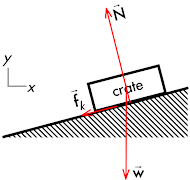Cuesta College, San Luis Obispo, CA
 A crate gradually decreases in speed, as it slides up along a ramp. The ramp is not frictionless. Identify the force(s) that do positive work on the crate.
A crate gradually decreases in speed, as it slides up along a ramp. The ramp is not frictionless. Identify the force(s) that do positive work on the crate. (A) w.
(B) N.
(C) fk.
(D) (Two of the above choices.)
(E) (All of the above choices.)
(F) (None of the above choices.)
Correct answer (highlight to unhide): (F)
 The three forces acting on the crate are:
The three forces acting on the crate are:normal force N (perpendicular outwards from the ramp surface);The definition of work done is W = F·s·cosθ, where the angle θ is measured between the direction of the force vector and the displacement vector (which points in the direction of motion) when drawn together "tail-to-tail."
weight force w (vertically downwards);
friction force fk (down along the ramp).
The angle θ between the normal force N (perpendicular outwards from the ramp surface) and the displacement vector s (up along the ramp) is 90°, and since cos(90°) = 0, the normal force does zero work on the crate.
The angle θ between the kinetic friction force fk (down along the ramp) and the displacement vector s (up along the ramp) is 180°, and since cos(180°) = –1, the kinetic friction force does negative work on the crate.
The angle θ between the weight force w (vertically downwards) and the displacement vector s (up along the ramp) is an obtuse angle between 90° and 180°, and since cosθ is negative for 90° < θ < 180°, the weight force also does negative work on the crate.

Thus there are no forces that do positive work on the crate.
Sections 70854, 70855, 73320
Exam code: quiz04w04K
(A) : 4 students
(B) : 22 students
(C) : 4 students
(D) : 11 students
(E) : 1 student
(F) : 30 students
Success level: 42%
Discrimination index (Aubrecht & Aubrecht, 1983): 0.71
No comments:
Post a Comment